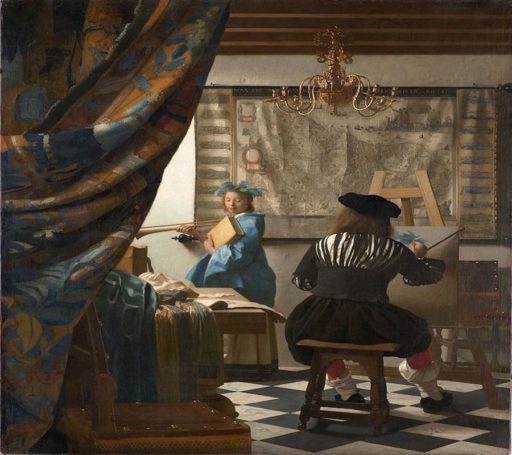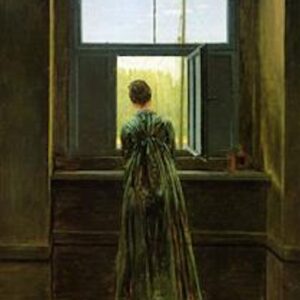Friday, November 12, 2021, was celebrated as Vermeer Day by Google. The reason for this celebration verges into the territory of the arbitrary, since the explanation for the special day of Vermeer-celebrating was that on November 12, 1995, exactly twenty-six years ago, there was a huge exhibit at The National Gallery in Washington D.C. where twenty-one of the thirty-five attested works of Vermeer were exhibited together. The semi-arbitrariness of this celebration is fine with me, actually, since arbitrariness is rather a good reason to go about celebrating something, or doing anything at all. When something is arbitrary, it is slightly out of one’s control. One chose, but one also didn’t choose. Something else did the choosing, if only the power of chance itself. But chance is, in fact, a power. There are always connections lurking, or, to put it another way, since everything is connected to everything in some way or another, the force of chance, the power of the arbitrary allows certain connections to make themselves manifest that might not, otherwise, find this manifestation.
For me, though, the chance series of mental connections created by seeing Vermeer paintings on the front page of Google was to remind me that I have long dabbled with a book that would be about Vermeer, more or less, about Vermeer in the garbled way that I like to write books about art, to write books about art in such a way that the art moves away from itself into other thoughts and feelings and reactions, into long and winding and sometimes repetitive mental wanderings that seem not to have much necessarily to do with the art at all and then, maybe, just when the reader least expects it, these ramblings make their way back into the art in surprising ways, ways that just might have managed to pick up a few not-completely-useless realizations along the way. Or so I would have it.
The thing that most amuses me about Vermeer is that people are always trying to tell us what the paintings are really about, how they can be decoded, what the symbols mean, that sort of thing. It is not an insane thing to do, since Vermeer lived at a time and within a milieu where it was, actually, considered important that painters make symbols, that paintings be signs and allegories and that they contain a kind of message embedded in the visual clues of the painting itself. But what is notable and actually completely revolutionary and mind-blowing about Vermeer is the degree to which he was trying to find a way out of this kind of painting, in which he was trying to blow-up that sort of painting, in which he could reveal his hatred of paintings that have such a direct symbolic meaning.
It is actually quite easy to see that Vermeer was an anti-symbolic painter if you have the eyes to look. That’s because he made a painting that so clearly and obviously is meant to be a funny painting, a hilarious painting even that exists for one simple reason, it exists to portray the absolute absurdity of making paintings that are supposed to be symbols for something else, that are supposed to be ‘read’ and translated according to the various objects within the painting and the meaning that those objects are supposed to carry.
Anyway, the painting is usually called The Art of Painting, or sometimes The Allegory of Painting, and was probably painted in about 1666. This painting has been analyzed by thousands of art historians and critics and the like. To my knowledge, no one has spoken the simple truth of this painting, no one dares to say it, to point out that the painting is frickin’ hilarious. The condition of painting, according to Vermeer, is that it is dumb, dumb to the point of absurdity. First of all, look at the painter in his act of painting. Look at his bunched-up seventeenth-century socks. They are ridiculous. Look at the frumpy man at his easel trying to capture this ridiculously contrived scene. His model is holding a book, and a trombone (okay, it is not really a trombone, it is whatever a trombone was in seventeenth century Delft), and she’s got a comical laurel on her head. She’s overburdened with symbols. Can you not see the joke here? Why do people not see the joke? Especially when all the other Vermeer paintings, the great ones that everyone loves, especially when all these paintings seem so painfully, so beautifully mute, so respectfully lacking in clear or obvious symbology. I mean, critics try to manufacture symbols anyway. Especially art historians. They can’t not do it. Poor souls.
But let us simply look. If The Art of Painting is a painting about painting, and it most obviously is, if this is a painting about painting then there is only one conclusion to be drawn. Painting is silly. Painting that forces a bunch of tired symbols onto the canvas simply to be read this or that way, this sort of painting is silly. The model is holding a trombone and a book. Why? It’s silly. She can barely hold them both. Vermeer thinks that painting ends up being ridiculous when it keeps trying to do this. The painting is funny, and it’s telling us exactly what Vermeer thinks painting must not be.
What should painting actually be, then? It would take me a book or two and lots of pointless rambling to answer that question. The fact is, I don’t want to answer the question and cannot. Vermeer can’t and won’t either. He prefers not to. But he did paint some canvases. And on those canvases, in quiet rooms where the light falls softly upon scenes glimpsed through a doorway, a place to which one was never invited, as wordless experience passes between persons with their attention focused on anything but us, in those rooms one encounters a mystery that is neither revealed nor concealed but that in some part of one’s soul has always and will always be known.
Morgan Meis has a PhD in philosophy and is a founding member of Flux Factory, an arts collective in New York. He has written for n+1, The Believer, Harper’s Magazine, The Virginia Quarterly Review and is a contributor at The New Yorker. He won the Whiting Award for non-fiction in 2013. Morgan is also an editor at 3 Quarks Daily, and a winner of a Creative Capital | Warhol Foundation Arts Writers grant. A book of Morgan’s selected essays can be found here. His new book from Slant is The Drunken Silenus. He can be reached at morganmeis@gmail.com.





